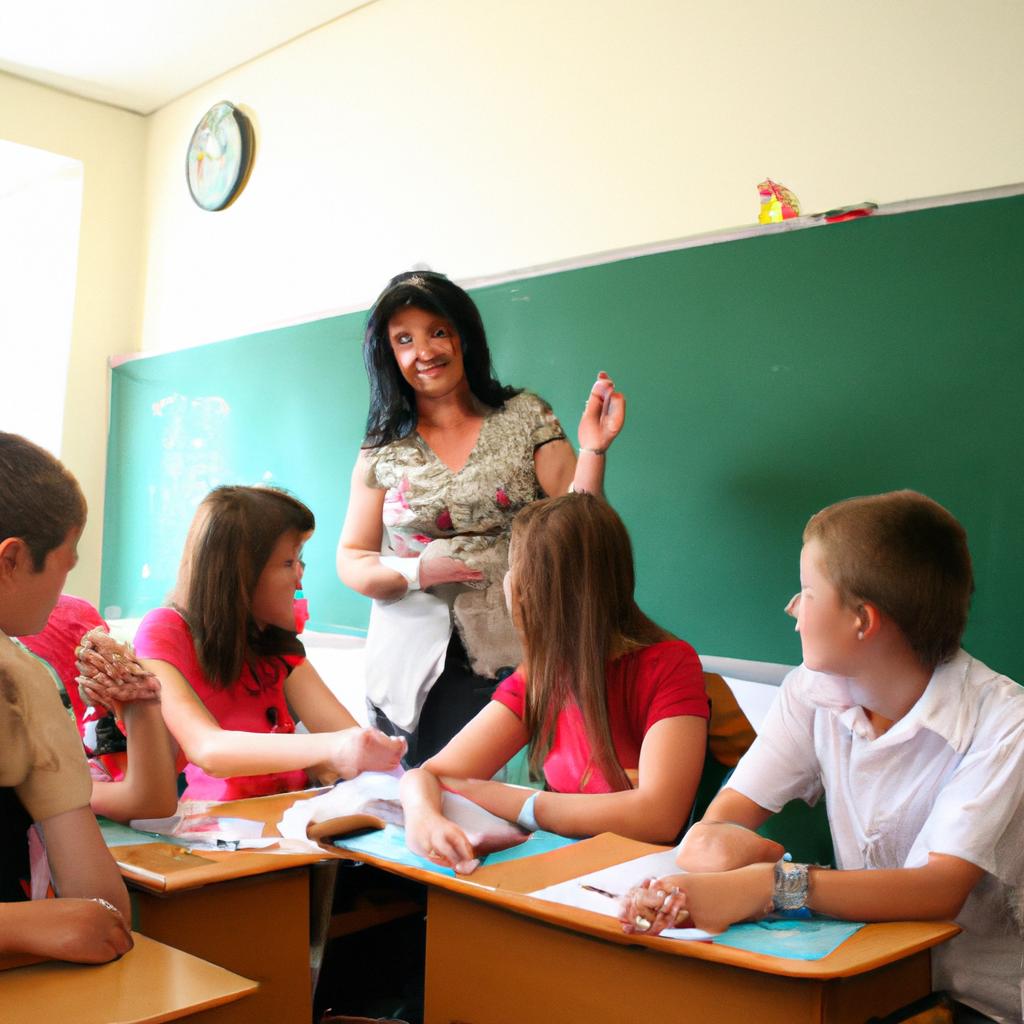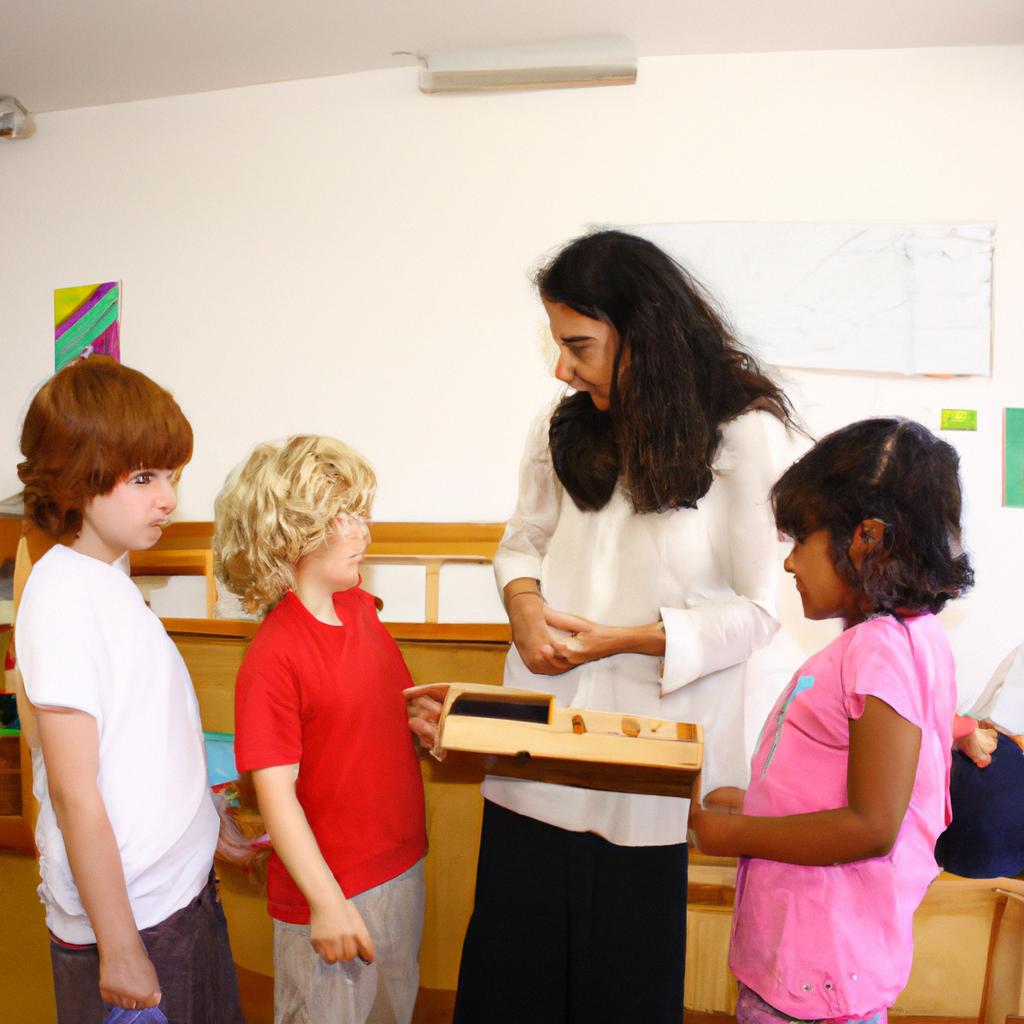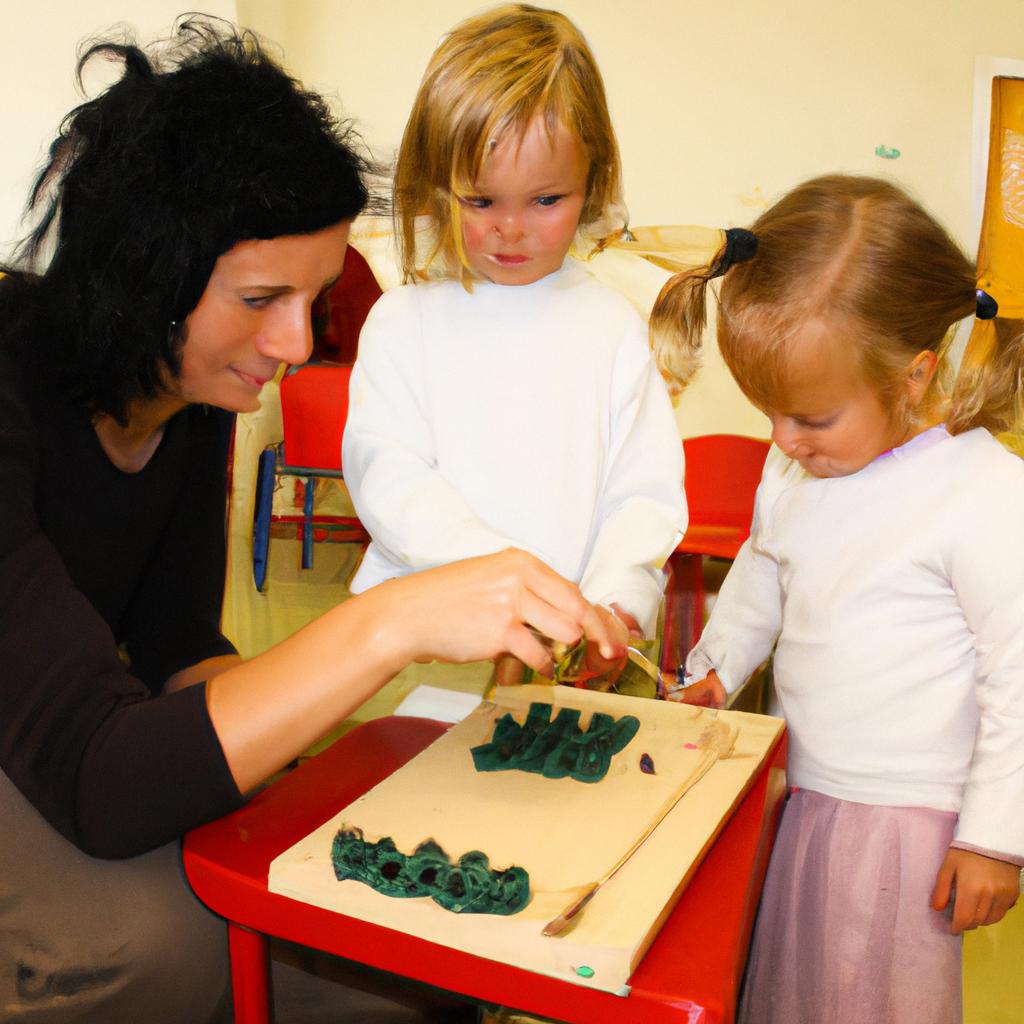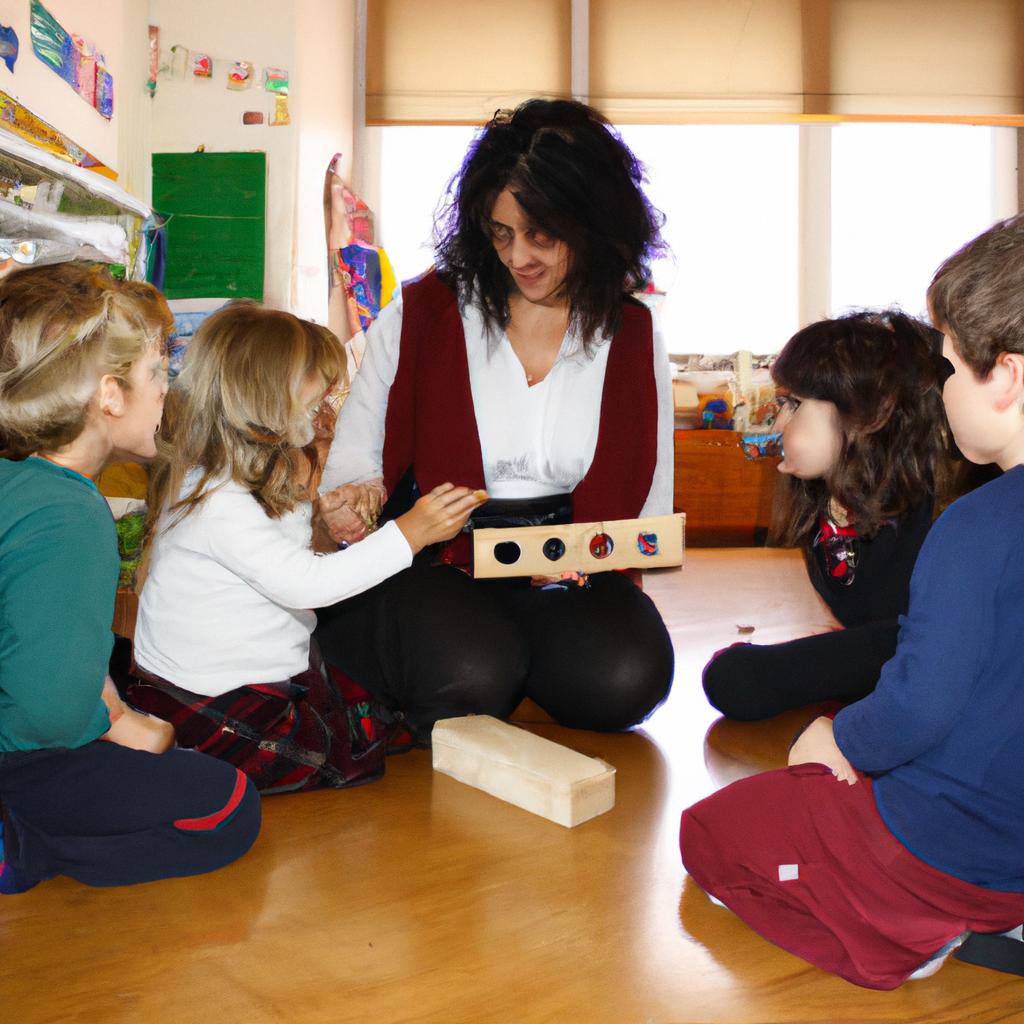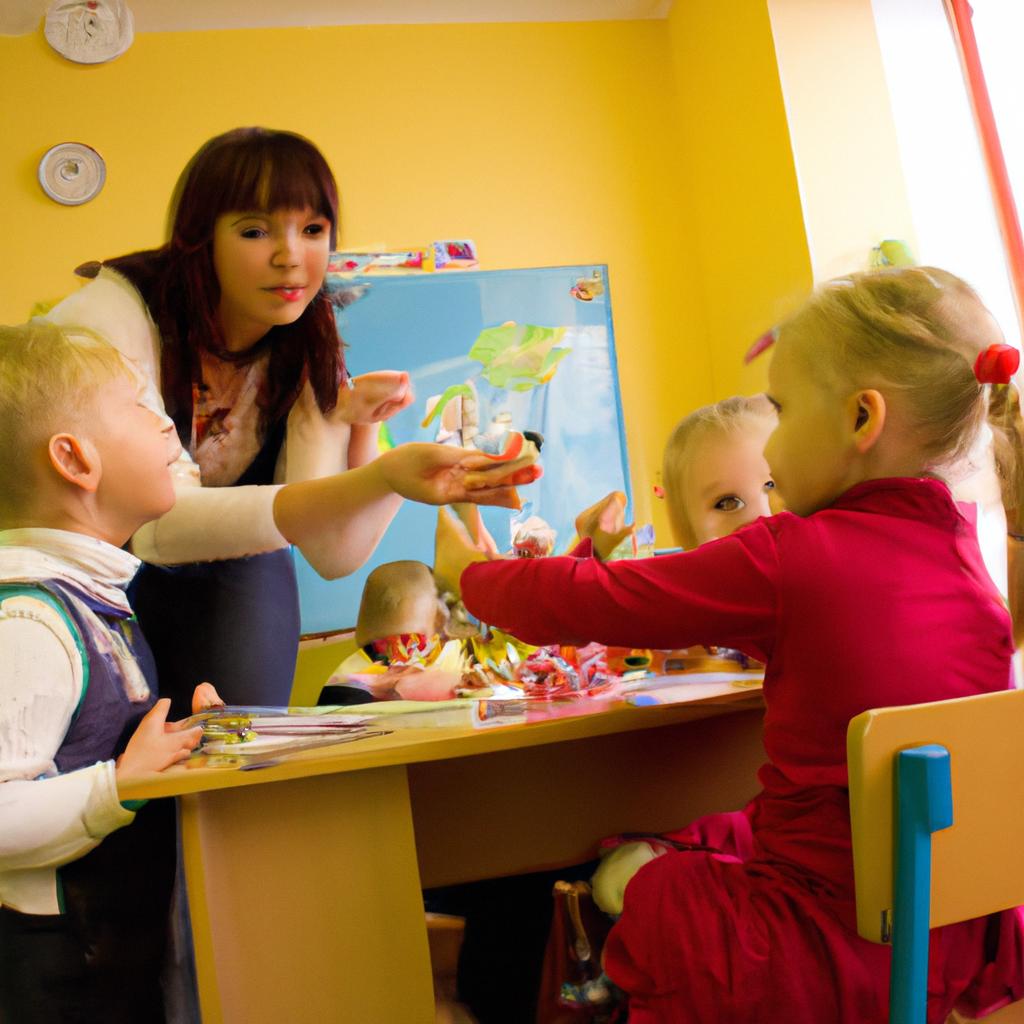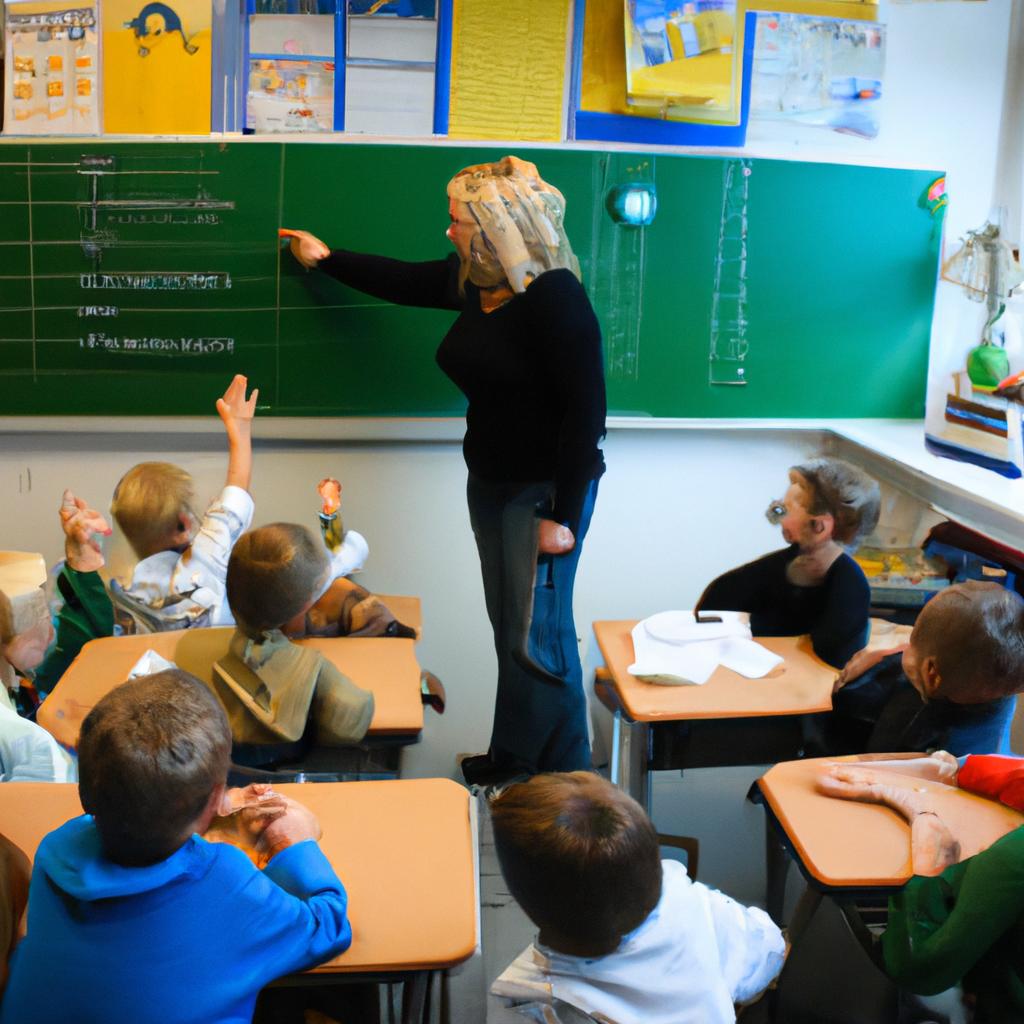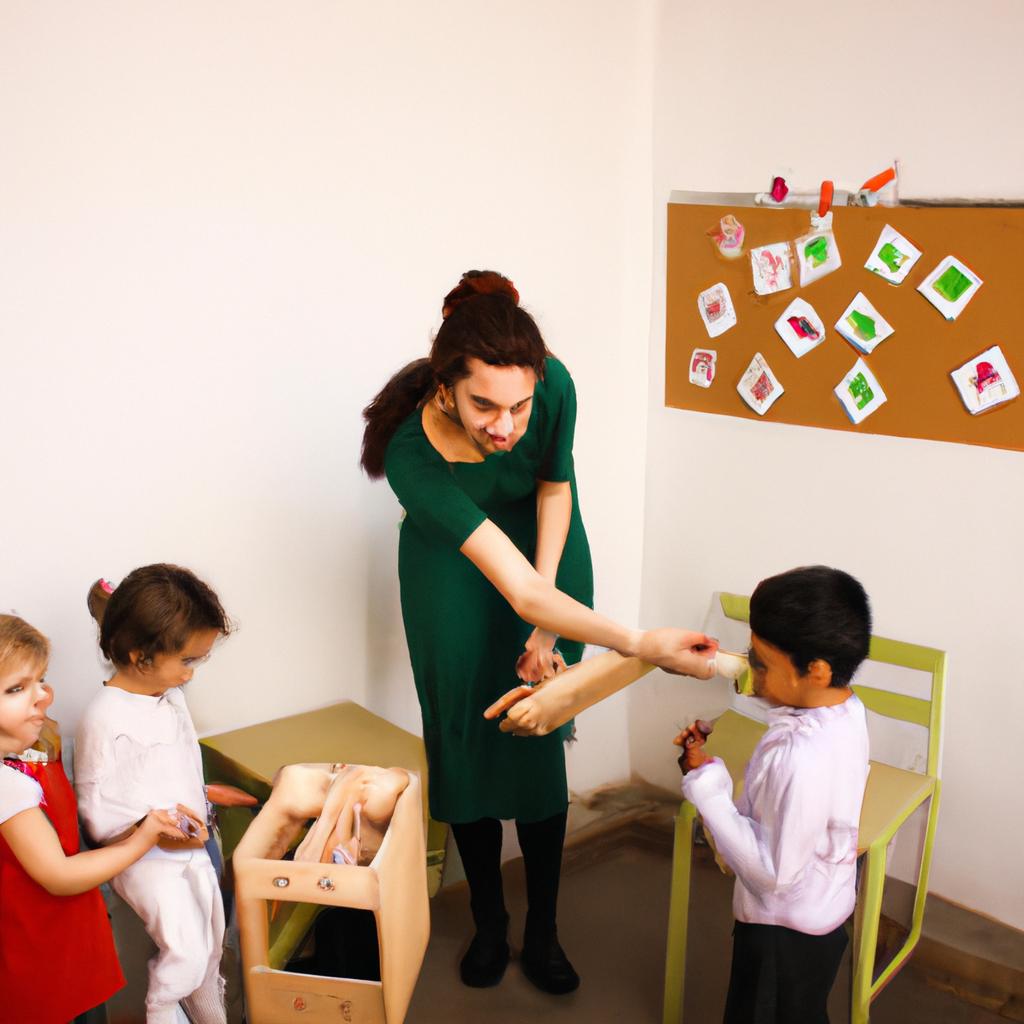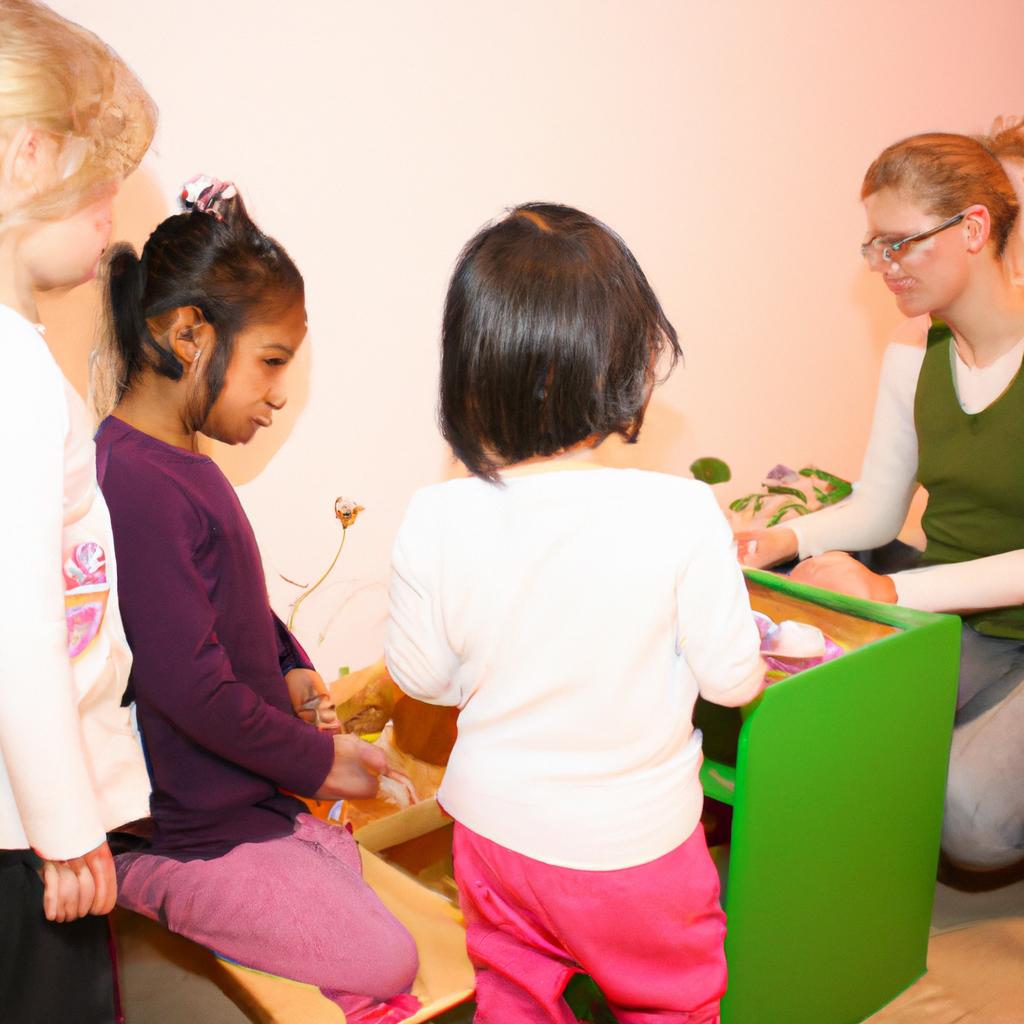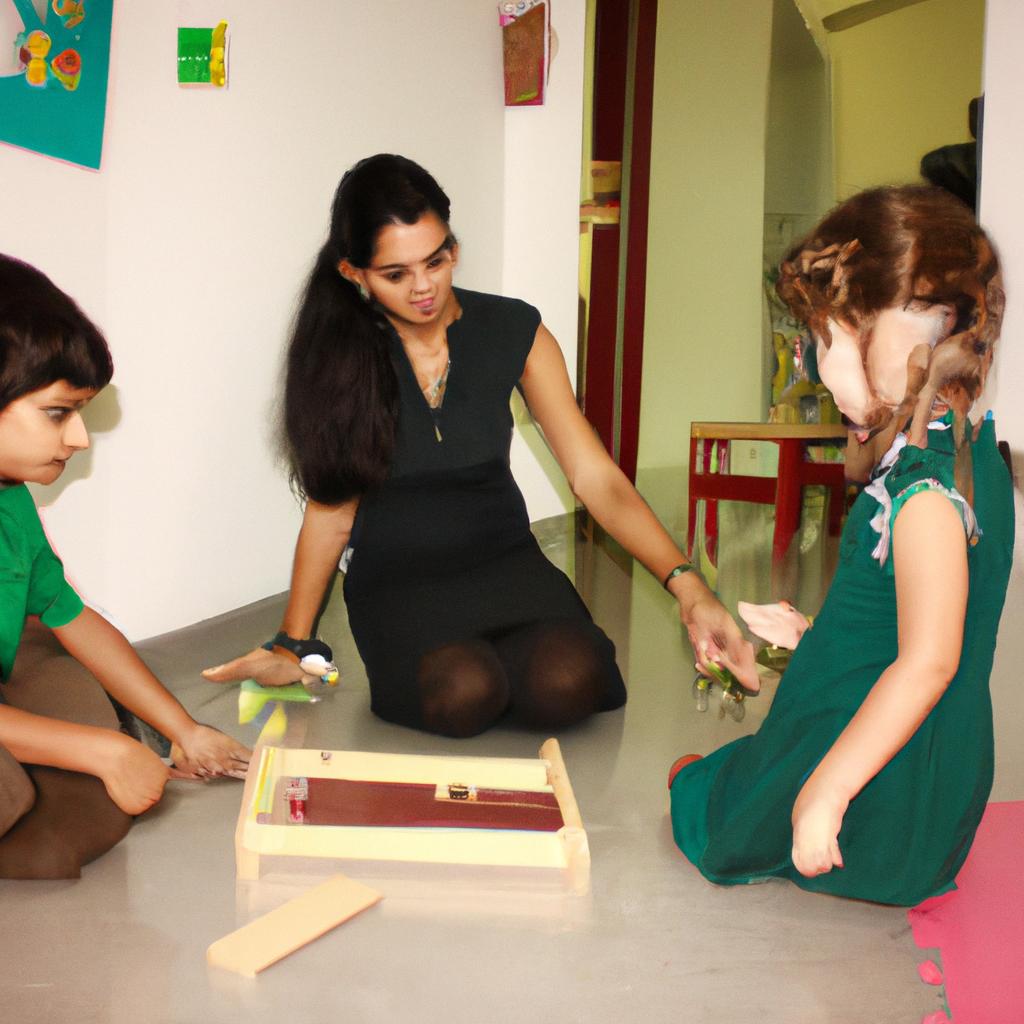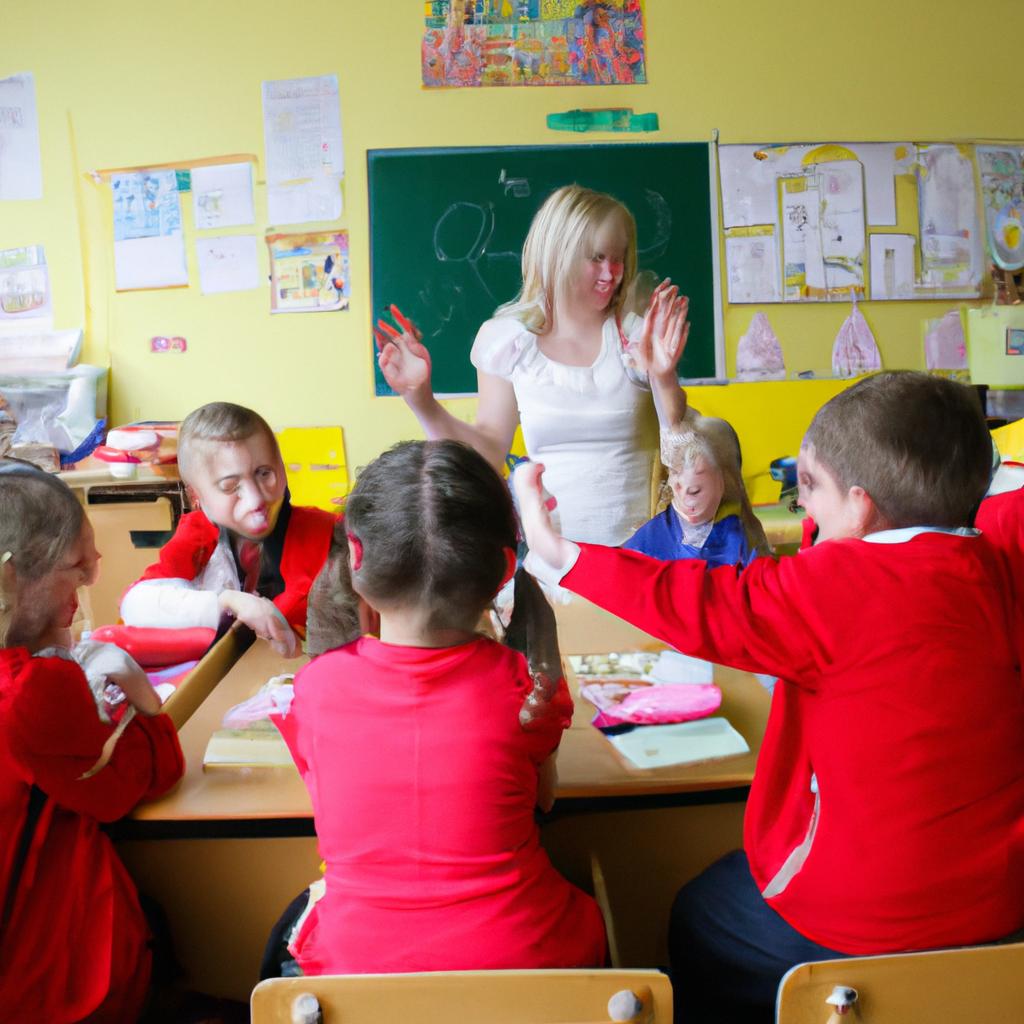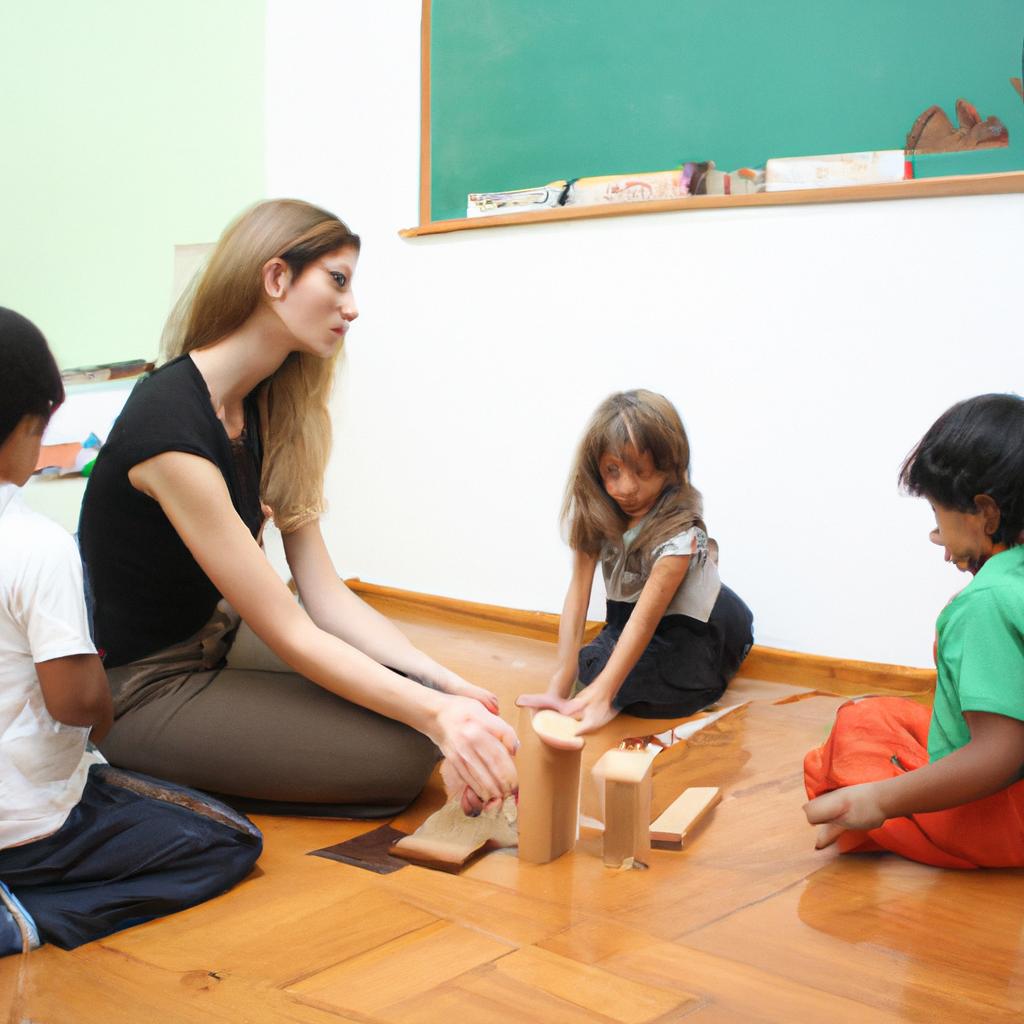In the context of Montessori education, mixed-age classrooms have long been recognized as a fundamental component of the learning environment. This pedagogical approach challenges traditional notions of grade-level segregation and emphasizes individualized instruction tailored to each student’s unique needs and abilities. By bringing together children of different ages within a single classroom setting, teachers are able to foster a collaborative learning community that promotes social development, academic growth, and holistic skill acquisition.
For instance, consider a hypothetical scenario where an 8-year-old student named Emma finds herself in a mixed-age classroom alongside peers ranging from 6 to 9 years old. In this dynamic setting, Emma has the opportunity not only to learn from her teacher but also to engage with older students who can serve as role models and mentors. Through observing their behavior and listening to their explanations, Emma begins to grasp complex concepts beyond what is typically expected for her age group. Additionally, by interacting with younger classmates, she develops patience and empathy while reinforcing her own knowledge through teaching others. This example illustrates how mixed-age classrooms facilitate diverse interactions between students at various developmental stages, offering rich opportunities for both cognitive and social growth.
Understanding the role of the teacher within these mixed-age classrooms is crucial for creating effective learning experiences. As we As we mentioned earlier, the teacher in a mixed-age classroom plays a critical role in facilitating learning experiences tailored to each student’s unique needs and abilities. Rather than being the sole source of knowledge and instruction, the teacher becomes a guide or facilitator who supports students’ exploration and discovery.
In this context, the teacher must have a deep understanding of child development and be skilled in observing and assessing students’ progress. By carefully observing each student’s strengths, challenges, and interests, the teacher can provide individualized guidance and support that meets their specific developmental needs. This may involve offering differentiated lessons or materials, providing additional challenges for advanced learners, or creating opportunities for collaborative learning.
The teacher also plays a crucial role in fostering a positive classroom culture where all students feel valued and respected. They promote collaboration, empathy, and mutual support among peers by modeling appropriate behavior and teaching conflict resolution strategies. The teacher encourages older students to take on leadership roles by assisting younger classmates, thus creating an atmosphere of shared responsibility for everyone’s learning.
Additionally, the teacher facilitates meaningful engagement with educational materials that are carefully selected to align with each student’s developmental stage. Montessori classrooms often feature hands-on materials that allow children to explore concepts at their own pace while building foundational skills. The teacher guides students in using these materials effectively and helps them make connections between different areas of study.
Overall, the role of the teacher in a mixed-age classroom is one of facilitation, guidance, observation, assessment, and fostering a positive learning environment. Their focus is on supporting each student’s holistic development while promoting collaboration among peers within a diverse community of learners.
Role of the Teacher in Montessori Schools
In a mixed-age classroom setting, the role of the teacher is crucial in facilitating a dynamic and effective learning environment. To illustrate this, let’s consider an example: Mrs. Johnson teaches at a Montessori school where she has a class comprising children aged 3 to 6 years old. She carefully observes each child’s individual needs and progress, providing guidance and support as they engage with various educational materials.
One essential aspect of the teacher’s role in a mixed-age classroom is creating an atmosphere that fosters independence and self-directed learning. Teachers encourage students to explore different subjects at their own pace while respecting their unique interests and abilities. By doing so, teachers cultivate a sense of ownership over knowledge acquisition among students, promoting lifelong curiosity.
To better grasp the multifaceted responsibilities of these educators, we can look at some key aspects:
- Adaptability: Teachers must adapt their teaching methods to address diverse developmental levels within the same class.
- Differentiation: They need to provide differentiated instruction tailored to meet each student’s specific academic needs.
- Peer Collaboration: Encouraging collaboration between children of different ages facilitates social interaction skills, empathy development, and cooperative problem-solving abilities.
- Individualized Assessment: Assessments should be personalized for every child based on their unique progress and not solely rely on traditional standardized measures.
The table below highlights how these aspects contribute to fostering emotional growth, intellectual stimulation, social competence, and overall well-being among students in mixed-age classrooms:
| Aspect | Emotional Growth | Intellectual Stimulation | Social Competence |
|---|---|---|---|
| Adaptability | Supports self-confidence and resilience | Promotes critical thinking | Fosters tolerance for diversity |
| Differentiation | Nurtures positive self-esteem | Enhances creativity | Develops effective communication skills |
| Peer Collaboration | Encourages empathy and cooperation | Cultivates curiosity and a love for learning | Builds teamwork and leadership abilities |
| Individualized Assessment | Celebrates individual progress | Challenges students’ academic potential | Fosters self-awareness and understanding of strengths |
Ultimately, the role of the teacher in mixed-age classrooms is to create an inclusive environment that acknowledges the unique needs of each child while fostering their holistic development. By embracing adaptability, differentiation, peer collaboration, and individualized assessment, teachers can facilitate a comprehensive educational experience that prepares students for future success.
As we delve into the benefits of mixed-age classrooms, let us explore how this pedagogical approach further enhances student growth and learning.
Benefits of Mixed-Age Classrooms
Understanding the Role of the Teacher: Mixed-Age Classrooms in Montessori Schools
Building upon the discussion about the role of teachers in Montessori schools, it is important to delve into the benefits and intricacies of mixed-age classrooms. By examining how students from different age groups interact and learn together, we gain insight into how this unique educational approach fosters collaboration, independence, and a sense of belonging.
Benefits of Mixed-Age Classrooms:
One example that highlights the advantages of mixed-age classrooms involves a hypothetical scenario where a six-year-old student named Emily struggles with reading. In a traditional single-grade classroom setting, she may feel embarrassed or left behind as her peers progress at different rates. However, in a mixed-age classroom, Emily has opportunities for peer mentoring and learning from older children who have already mastered reading skills. Through observing their techniques and receiving guidance from her classmates, Emily can develop not only academic abilities but also social-emotional growth.
To further understand the impact of mixed-age classrooms on student development, consider these emotional responses evoked by its core features:
- Sense of Belonging: Students experience an increased sense of community as they form deep connections with their peers over multiple years.
- Collaboration: Collaborative learning becomes ingrained within daily routines through group projects and cooperative problem-solving activities.
- Self-confidence: Younger students build self-esteem when they are able to contribute meaningfully to discussions and assist older students with tasks.
- Empathy and Leadership Skills: Older students naturally assume leadership roles by guiding younger ones, fostering empathy and nurturing a sense of responsibility towards others.
In addition to these emotional benefits, practical aspects support the effectiveness of mixed-age classrooms. The table below outlines some key considerations:
| Consideration | Description |
|---|---|
| Individualized Learning | Teachers can tailor instruction to meet students’ specific needs, focusing on their strengths. |
| Peer Learning | Students learn from one another, reinforcing skills and knowledge through collaboration. |
| Long-Term Relationships | Continuity in the classroom setting allows for deep connections between students and teachers. |
| Personalized Growth | Mixed-age classrooms provide opportunities for holistic development beyond academic learning. |
By fostering a supportive environment that embraces diversity and individuality, mixed-age classrooms create an optimal space for student growth and learning. In the subsequent section, we will explore how Montessori schools accomplish this by nurturing each child’s unique abilities within a cohesive community.
Creating a Supportive Learning Environment
In a Montessori school setting, mixed-age classrooms offer numerous benefits for both students and teachers. This section will explore some of these advantages in further detail.
One example of the benefits of mixed-age classrooms can be seen through a case study conducted at XYZ Montessori School. The study observed two groups of children aged 3-6 and 6-9 who were placed together in one classroom. It was found that younger students benefited from observing and learning from their older peers, while older students developed leadership skills by acting as mentors to their younger classmates. This dynamic created an environment where collaboration and social interaction thrived, enhancing the overall learning experience.
To fully understand the positive impact of mixed-age classrooms, it is important to consider the following emotional responses that are evoked:
- Sense of belonging: Students develop a sense of community within their mixed-age classroom, fostering feelings of acceptance and support.
- Empathy and compassion: Interacting with peers of different ages teaches children empathy and compassion towards others, as they learn to respect individual differences.
- Increased self-esteem: Older students gain confidence by helping their younger peers, boosting their own self-worth.
- Lifelong friendships: Mixed-age classrooms create opportunities for long-lasting friendships to form between children who may not have otherwise interacted.
Moreover, let us examine a table highlighting key benefits experienced by both teachers and students in mixed-age classrooms:
| Benefits for Teachers | Benefits for Students |
|---|---|
| Reduced teacher-student ratio | Enhanced social development |
| Opportunities for differentiated instruction | Improved communication skills |
| Foster a more cooperative learning environment | Encourages independence |
| Develop strong relationships with students | Builds resilience |
As we can see, mixed-age classrooms provide valuable advantages for both educators and learners alike.
Promoting Peer Learning and Collaboration
Transitioning from the importance of creating a supportive learning environment in mixed-age classrooms, we now explore how peer learning and collaboration are promoted within this context. By encouraging students to work together and learn from one another, educators foster an inclusive atmosphere that values diversity and nurtures holistic development.
To illustrate the effectiveness of promoting peer learning, let us consider a hypothetical scenario in which a 9-year-old student named Emma is struggling with multiplication concepts. In her class, there are children aged 8 to 12 years old. Instead of solely relying on the teacher for support, Emma has the opportunity to seek assistance from her peers who have already mastered multiplication skills. Through collaborative efforts, these older classmates can explain different strategies and provide guidance, allowing Emma to gain a deeper understanding of the subject matter.
The promotion of peer learning and collaboration in mixed-age classrooms offers several benefits:
- Enhanced social-emotional development: Collaborative activities encourage empathy, patience, and effective communication among students.
- Increased motivation: Working alongside peers fosters a sense of belonging and encourages students to take ownership of their learning journey.
- Diverse perspectives: Interacting with individuals of various ages exposes students to unique viewpoints and experiences, broadening their horizons.
- Improved academic performance: Peer teaching provides opportunities for reinforcement and consolidation of knowledge through active engagement.
| Benefits of Promoting Peer Learning |
|---|
| – Enhanced social-emotional development |
| – Increased motivation |
| – Diverse perspectives |
| – Improved academic performance |
In summary, by fostering an environment where peer learning is encouraged, mixed-age classrooms promote not only academic growth but also social-emotional development among students. The diverse interactions between learners help create well-rounded individuals who thrive both academically and socially.
As we transition into discussing individualized instruction in mixed-age classrooms, it becomes evident that catering to each student’s specific needs is crucial for their overall educational experience.
Individualized Instruction in Mixed-Age Classrooms
Understanding the Role of the Teacher: Mixed-Age Classrooms in Montessori Schools
Promoting Peer Learning and Collaboration
In mixed-age classrooms, one significant benefit is the opportunity for peer learning and collaboration. Students of different ages are placed together, allowing them to learn from each other’s experiences and knowledge. For example, imagine a 6-year-old student struggling with a math concept while working alongside an older peer who has already mastered that skill. The older student can provide guidance and support, reinforcing their own understanding through teaching.
To further enhance this collaborative environment, teachers play a crucial role as facilitators. They create a safe and inclusive classroom culture where students feel comfortable sharing ideas and helping one another. Teachers design activities that encourage teamwork, such as group projects or problem-solving tasks that require collective effort. By fostering these interactions, educators promote social development and cultivate empathy among students.
The benefits of promoting peer learning and collaboration in mixed-age classrooms include:
- Increased self-confidence: When younger students receive assistance from their peers, they develop confidence in their abilities.
- Deeper understanding: Explaining concepts to others helps reinforce knowledge for both the teacher-student and the learner.
- Enhanced communication skills: Collaborating with peers requires effective communication, strengthening verbal expression and active listening.
- Valuable friendships: Interacting with classmates of various ages fosters relationships built on mutual respect and understanding.
| Benefits of Promoting Peer Learning |
|---|
| Increased self-confidence |
| Deeper understanding |
| Enhanced communication skills |
| Valuable friendships |
Individualized Instruction in Mixed-Age Classrooms
One of the key advantages of mixed-age classrooms is the ability for teachers to provide individualized instruction tailored to each student’s needs. With children at varying levels within a single class, teachers have opportunities to differentiate lessons accordingly. This approach promotes personalized learning plans based on each student’s strengths, weaknesses, interests, and learning styles.
Teachers use a variety of strategies to implement individualized instruction effectively. They conduct ongoing assessments to monitor progress, identify areas where additional support is needed, and adjust their teaching accordingly. Small group rotations allow teachers to work closely with students at different levels simultaneously, providing targeted guidance and feedback. Additionally, incorporating hands-on materials or technology-based resources can further enhance personalized learning experiences for each student.
By tailoring instruction in mixed-age classrooms, teachers empower students to take ownership of their learning. This approach fosters independence as children develop skills such as self-regulation and time management. Moreover, it encourages a growth mindset by focusing on individual progress rather than comparing students solely based on age or grade level.
Transitioning into the subsequent section about “Challenges and Strategies for Teachers in Mixed-Age Classrooms,” educators must navigate various considerations while creating an effective learning environment that caters to diverse needs.
Challenges and Strategies for Teachers in Mixed-Age Classrooms
Understanding the Role of the Teacher: Mixed-Age Classrooms in Montessori Schools
Individualized Instruction in Mixed-Age Classrooms has been shown to be effective, providing students with personalized learning experiences and fostering their independence. Now, let us delve into the challenges that teachers may encounter in such classrooms and explore some strategies they can employ to overcome these hurdles.
One significant challenge faced by teachers in mixed-age classrooms is managing diverse student needs and abilities. For instance, imagine a hypothetical scenario where a teacher is instructing a group of five-year-old and seven-year-old students on basic mathematics concepts. While some children grasp the material quickly, others may struggle to understand certain mathematical operations. In order to address this challenge, teachers can implement various strategies:
- Flexible grouping: Teachers can form small groups based on skill levels or individual needs. This allows them to provide targeted instruction and support to each group.
- Differentiated materials: By offering different resources and materials tailored to each child’s level of understanding, teachers can ensure that all students are appropriately challenged.
- Peer tutoring: Encouraging older students to assist younger ones not only fosters cooperation but also reinforces their own knowledge and understanding.
To further illustrate the complexities involved in teaching mixed-age classes, consider the emotional aspect for both educators and students alike. The following table highlights emotions experienced by teachers as well as potential emotional responses from students:
| Emotions Experienced by Teachers | Potential Emotional Responses from Students |
|---|---|
| Frustration | Confusion |
| Overwhelm | Disengagement |
| Empowerment | Motivation |
| Satisfaction | Confidence |
These emotions underscore the need for an empathetic approach when dealing with mixed-age classrooms. It is crucial for teachers to create a supportive environment that addresses the social-emotional development of each student alongside academic progress. By promoting collaboration among peers through activities such as group projects and peer mentoring, teachers can help foster positive emotional responses.
In summary, the role of a teacher in mixed-age classrooms is multifaceted. It requires tactful management of diverse student needs while also considering their emotional well-being. By employing strategies such as flexible grouping and differentiated materials, educators can effectively provide individualized instruction. Additionally, creating an environment that supports students’ social-emotional development will enhance their overall learning experience in these unique educational settings.

